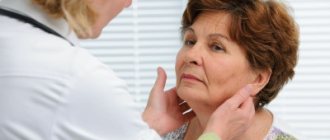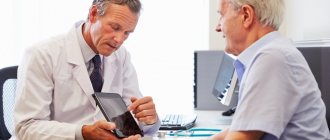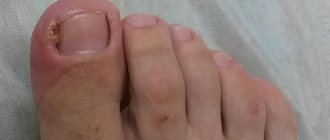Cholecystitis
Which doctors should I contact?
After detecting symptoms indicating cholecystitis, you should immediately consult a doctor.
Usually in such cases they turn to a surgeon, therapist, gastroenterologist, and in acute cases call an ambulance. All patients with acute cholecystitis and suspected of having this disease are subject to referral to a surgical hospital with a team of qualified surgeons and anesthesiologist on duty around the clock. In severe cases, the participation of a resuscitator is required. Treatment of cholecystitis
The main goals of treatment of chronic acalculous cholecystitis are relief of pain and inflammation in the gallbladder, correction of digestive and metabolic disorders, treatment of complications and concomitant diseases.
- During the period of exacerbation, patients with chronic cholecystitis are recommended bed rest, fasting for 1-3 days, then diet therapy - limiting fatty foods and their calorie content (diet No. 5, 5A), eating 4-6 times a day.
- Antispasmodics and analgesics are the main drugs for the treatment of exacerbation of cholecystitis, allowing to alleviate biliary colic.
- Analgesics are used to relieve pain.
- To stop the infectious inflammatory process, broad-spectrum antibiotics are prescribed.
- When helminthiasis is confirmed, anthelmintic drugs are used.
- Relief of dyspeptic disorders is carried out with the help of enzymatic, antiemetic drugs that suppress gastric secretion, etc.
- Violation of the outflow of bile is corrected with choleretic agents.
- If the stones are cholesterol, then there is a possibility of dissolving them with the help of drugs based on ursodeoxycholic acid.
Lithotripsy is a shock wave method that is used to crush stones, which are subsequently safely removed from the body or dissolved.
The selection criterion for patients for this procedure is limited by the size of the stones - single stones no more than 2 cm, a few up to 1 cm. The standard solution for the treatment of chronic calculous cholecystitis is surgical intervention, which eliminates new exacerbations and possible complications. Laparoscopic cholecystectomy is the main surgical method for treating chronic calculous cholecystitis. Removal of the gallbladder is performed with special instruments through one or more small incisions in the abdominal wall. Complications
Cholecystitis can lead to a number of serious complications.
- Due to inflammation, the gallbladder can stretch and increase in size (dropsy), which increases the risk of its rupture (perforation) and the development of peritonitis.
- Stagnation of bile in the gallbladder is a risk factor for infection of bile by bacteria, as a result of which the infection can enter the bloodstream with the development of sepsis.
- Violation of blood microcirculation in the wall of the gallbladder with the further development of ischemia and focal or total necrosis of the wall is the cause of gangrene of the gallbladder.
The following complications of cholecystitis require emergency surgical care:
- empyema of the gallbladder - accumulation of pus in the cavity of the gallbladder;
- peri-vesical infiltrate and abscess - an inflammatory process that spreads beyond the gallbladder;
- perforation is a rupture of the wall of the gallbladder with the release of its contents into the abdominal cavity.
Intraoperative complications include bleeding and bile duct injury.
Postoperative complications include pneumonia, myocardial infarction, thromboembolic complications, and pulmonary embolism. Prevention of cholecystitis
Primary prevention consists of eliminating risk factors leading to the development of chronic cholecystitis - timely sanitation of the biliary tract, elimination of dyskinesia, early detection of stones in the gallbladder and timely adequate treatment, including surgery.
Secondary prevention involves reducing the frequency of relapses, preventing the progression of the disease and the development of complications. Active identification of patients with clinically pronounced forms of chronic cholecystitis, frequent exacerbations and their adequate non-drug and drug therapy.
Diet plays a significant preventive role - low-calorie, predominantly plant-based food is useful, the use of vegetable fats containing polyunsaturated fatty acids, phospholipids, vitamin E, which help normalize cholesterol metabolism, participate in the synthesis of prostaglandins that dilute bile, and increase the contractile function of the gallbladder. Vegetable fats are especially important for bile stagnation. Vegetables, fruits, and bran promote the discharge of bile, reduce the cholesterol content in bile, thereby reducing the likelihood of stone formation.
Sources:
- National clinical guidelines “Acute cholecystitis”. Russian Society of Surgeons, 2015.
- Beburishvili A.G., Panin S.I., Zyubina E.N., Bykov A.V. Optimal timing of surgical treatment of acute cholecystitis according to evidence-based studies. Annals of surgical hepatology. 2020;25(3):12-19.
- Vorotyntsev A.S. Modern ideas about the diagnosis and treatment of cholelithiasis and chronic calculous cholecystitis. "Attending doctor". No. 02, 2012.
IMPORTANT!
The information in this section cannot be used for self-diagnosis and self-treatment. In case of pain or other exacerbation of the disease, diagnostic tests should be prescribed only by the attending physician. To make a diagnosis and properly prescribe treatment, you should contact your doctor.
What pain occurs in chronic cholecystitis?
All chronic diseases associated with the pathways for the outflow of bile are accompanied by lethargy, nausea, vomiting, pain in the abdomen and in the heart area. People who suffer from these diseases spend a long time trying to find the cause of their illness, going through a huge number of doctors. Experts may make the wrong diagnosis for a long time, confusing cholecystitis or dyskinesia with gastritis, ulcers or rheumatism. This error can also occur in the opposite direction. The patient will be treated for diseases of the biliary tract, and the cause of all the pain was an ulcer or gastritis.
Elderly people who are faced with diseases such as cholecystitis note the absence of pain and attacks. This phenomenon occurs due to the fact that in old age, people’s sensitivity decreases, and as a result, pain sensitivity.
pain in the back and in the right hypochondrium due to cholecystitis
People suffering from chronic cholecystitis may experience unpleasant symptoms such as heartburn and nausea, as well as a bitter taste in the mouth and belching. There is a possibility of bad stool, diarrhea and constipation. The central nervous system, which cannot function normally, is also involved in this. The person becomes aggressive and irritated, cannot sleep well and get enough sleep. Nervousness and anger appear.
What does the doctor evaluate?
Doctor sees signs of chronic cholecystitis ultrasound
. The length of the organ, its thickness, width, condition of the mucous membrane, contours, volume and shape of the gallbladder. As well as the location and presence of foreign bodies.
After eating, a healthy person's bile duct decreases by about 55% compared to the study on an empty stomach.
A healthy person should have a gallbladder:
- 6-9 cm long, 2 or 4 cm wide.
- Wall thickness no more than 3 mm.
- The shape should be pear-shaped, with clear contours.
Of course, the indicators may differ slightly depending on the individual characteristics of the organism.
What can you see on an ultrasound?
Using this research method, the following diseases can be diagnosed:
- different forms of cholecystitis,
- abnormalities in the development of the gallbladder during embryogenesis,
- gallbladder stones,
- tumor processes,
- agenesis,
- hydrocele of the gallbladder,
- organ enlargement.
what can be seen on an ultrasound
Only timely detection of the disease makes it possible to carry out full treatment. Most diseases can be cured with medications. In advanced cases, one can only hope for surgical intervention.
Usually the research takes about an hour, or even two. Therefore, it should only be carried out if prescribed by a doctor.
The person should lie down on the couch and remove clothes to the waist. To make the picture clearer, you need to lubricate the area with silicone gel. Using the sensor, the doctor can determine the structural features of the organ, its size, and more. A prerequisite is to carry out the procedure on an empty stomach.
Then you need to study the function of the organ. In this case, the patient should have breakfast before the procedure. Then the doctor will receive a picture before and after eating. It is best to use boiled chicken eggs for breakfast.
After the food has been digested a little, you need to conduct the study again. It is important to perform ultrasound in different positions of the patient.
Risk factors
There are various forms of predisposition to the disease associated with individual characteristics, primary pathologies, nutrition and heredity. Doctors must take into account the presence of risk factors for cholecystitis during examinations.
Key risk factors:
- Female gender and age from 25 to 45 years.
- Obesity and significant weight loss over several months.
- Taking certain medications. In particular, the risk of developing inflammation in the gallbladder increases with the use of hormonal drugs.
- Pregnancy.
- Chronic diseases of the intestines, liver and pancreas.
- Surgical treatment of abdominal organs, trauma.
- Chronic foci of inflammation in different parts of the body.
- Long-term parenteral nutrition.
- Poor nutrition or prolonged fasting.
- Alcohol abuse.
- Myocardial infarction and other heart diseases.
- Vascular disorders in diabetes mellitus.
- Abnormal reflux of pancreatic secretions into the gallbladder (pancreatobiliary reflux).
- Insufficient physical activity.
Effective measures to prevent pathology are based on the elimination of risk factors and are associated with the patient’s lifestyle and individual medical history.
Diagnostics
A gastroenterologist can prescribe the necessary examinations for the patient. During the appointment, the doctor will ask the patient about complaints and study anamnestic information. A physical examination may reveal jaundice, bloating, and tenderness in certain areas of the body. Based on the data received, the doctor will prescribe the necessary instrumental and laboratory tests.
Necessary diagnostic procedures:
- Ultrasound examination of the gallbladder and bile ducts. The advantages of the method are safety and real-time imaging of organs. The doctor can immediately detect stones in the gallbladder, changes in the walls of the organ and other pathological signs indicating cholecystitis.
- Blood tests to identify inflammatory and infectious processes. With severe inflammation in the blood, the number of leukocytes increases. Also a diagnostic criterion is the concentration of liver enzymes.
- Collecting bile from an organ using duodenal intubation. The specialist sends the resulting material to the laboratory to detect pathogenic microflora.
- X-ray contrast examination of the gallbladder (cholecystography). The doctor receives information about the size, shape and functional activity of the organ. Using this study, you can detect anatomical abnormalities, gallstone disease or other ailments.
If the doctor is unable to make a diagnosis after requesting the results of the listed tests, an additional gastroscopy, computed tomography or survey laparoscopy may be prescribed. It is necessary to determine the cause of inflammation as accurately as possible.
Prevention
In order to reduce the risk of exacerbations and attacks of cholecystitis, you need to adhere to proper nutrition and diets. It is necessary to give up all bad habits, lead an active lifestyle, play sports and keep yourself in good shape. You need to pay attention to all kinds of infectious diseases and not let them get to you. A person suffering from such an illness needs to eliminate stress and conflict situations from his life as much as possible.
If a person has already been diagnosed with any disease, then he needs to be periodically examined by a gastroenterologist and engage in disease prevention. It must be remembered that all exacerbations of chronic diseases usually occur in autumn and spring.










